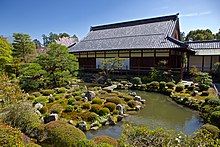9th century
This article needs additional citations for verification. (January 2017) |
| Millennium |
|---|
| 1st millennium |
| Centuries |
| Timelines |
| State leaders |
| Decades |
| Categories: |
|
Births – Deaths Establishments – Disestablishments |
The 9th century was a period from 801 (represented by the Roman numerals DCCCI) through 900 (CM) in accordance with the Julian calendar.
The
West Africa
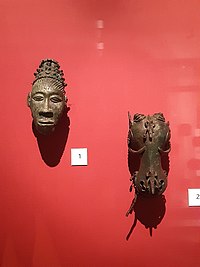
Southeastern Nigeria
Around the 9th century, the Igbo people of what is now southern Nigeria developed bronze casts of humans, animals, and legendary creatures. These bronzes, which were used as vessels, amulets, pendants, and sacrificial tools, are among the earliest made bronzes ever found in Nigeria. Most items were part of a burial of a nobleman culture in the northern part of the Igboland.
Ghana Empire
The
Western Europe
Britain and Ireland
Art
Art in the 9th century was primarily dedicated to the Gospel and employed as basic tools of liturgy of the Roman Orthodox Church. Thousands of golden art objects were made: Sacred cups, vessels, reliquaries, crucifixes, rosaries, altarpieces, and statues of the Virgin and Child or Saints all kept the flame of western art from dying out. Architecture began to revive to some extent in the West by the 9th century, taking the form of Church facilities of all kinds, and the first castle fortifications since Roman times began to take form in simple "moat and bailey" castles, or simple "strong point" tower structures, with little refinement.
Events

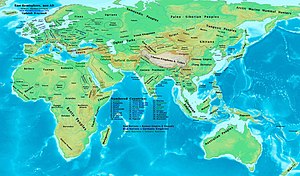
- 800s: Southeast Asian kingdoms of Muja (then pagan Brunei/Vijayapura) and Mayd (Ma-i) waged war against the Chinese Empire.[2]
- Khmer empireand establishes the Angkorian dynasty.
- 803: Construction on the Leshan Giant Buddha in Tang dynasty China is complete, after 90 years of rock-carving on a massive cliff-side.
- 805–820: Tang dynasty was under the rule of Emperor Xianzong of Tang.
- Byzantine empire and Bulgaria.
- Nicephorus I.
- 813: Byzantines are heavily defeated by the Bulgars at Versinikia.
- 813: China is reunited.[clarification needed]
- c. 813 – c. 915: Period of serious Arab naval raids on shores of Tyrrhenian and Adriatic seas.
- 814: Charlemagne dies in the city of Aachen.
- 30-year peace agreementis signed between Bulgaria and the Byzantine Empire.
- The Compendious Book on Calculation by Completion and Balancing.
- 824: Han Yu dies.
- Battle of Ellandun: King Egbert of Wessex defeats Mercia and establishes the kingdom of Wessex as the supreme Kingdom in England.
- 825: Borobudur is completed during the reign of Samaratungga.[3][4]
- Aghlabids established emirate (province) in Sicilyand subsequently raids Southern Italy.
- Ghana (Wagadu) Empireis established.
- The Compendious Book on Calculation by Completion and Balancing, a book of algebra, is also written there by Al-Khwarizmi.
- Sweet Dew Incident occurs. Emperor Wenzong of the Tang dynasty conspires to kill the powerful eunuchsof the Tang court, but the plot is foiled.
- Vlastimir defeats Presian.
- 840: Death of Louis the Pious.
- 841: Dublin is founded on the east coast of Ireland by the Vikings.
- 842: Samaale becomes chief of the Hashiyah clan and launches the conquest of Somalia. This paves the way for Hashiyic colonisation of the Peninsular, displacing the native Cushitic peoples of Somalia
- Carolingian empire into three divisions; East Francia was given to Louis the German, West Francia to Charles the Bald and Middle Francia to Lothair I.
- 844: The first Viking raid in Iberia
- 845: Buddhism is persecuted and banned in China.
- Emperor Xuānzong of Tang reigned. He was considered[by whom?] the last capable emperor of the Tang dynasty.
- 846: 11,000 Saracen Arab squadrons from Africa, with 500 horses, desecrate Christian shrines in Rome, including the tombs and basilicas of Sts. Peter and Paul.
- 848–852: The west bank of the Tiber is annexed into the city of Rome. A defensive wall, commissioned by Pope Leo IV, is built around what came to be called the Leonine City as a defensive response to the Saracen desecration of Rome in 846.
- 850–875: The first Norse settlers arrive on Iceland.
- 850s: The Muslim Berber dynasty Banu Isam is founded in Ceuta.
- municipaladministration functioned.
- 856: Prambanan is completed.[8] According to the Shivagrha inscription, Rakai Pikatan — the husband of Pramodhawardhani — defeated Balaputra.
- University of Al Karaouine as a madrasa in Fez, Morocco.
- Nalanda inscription.[9]
- 861: Assassination of Abbasid caliph al-Mutawakkil (r. 847–861) and decline of the Abbasid Caliphate.
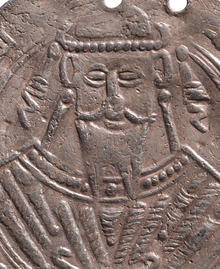
Coin issued during al-Mutawakkil's reign in the mid-9th century - Rurik dynasty in Rus'.
- 863: The Chinese author Duan Chengshi describes the slave trade, ivory trade, and ambergris trade of Somalia in East Africa.
- 862: The Bagratuni dynasty of Medieval Armenia begins with Ashot I.
- 863–879: Period of schism between Eastern and Western churches.
- 864: Christianization of Bulgaria under Boris I
- 867: Onward revival of the Byzantine Empire under the Macedonian dynasty.
- Tuluniddynasty.
- earthquake and tsunami struck Japan's Sanriku coast, killing 1,000 people.
- 869–883: Zanj Rebellion against the Abbasids
- Christianization of the Serbs.
- 870: Prague Castle founded.
- 871–899: Reign of Alfred the Great, the first king of the English.
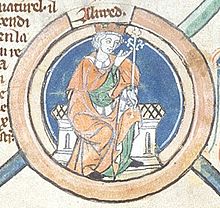
Alfred the Great led Wessex at its height in the 9th century - Ingolfur Arnarson from Norway.
- 875–884: Huang Chao leads an unsuccessful rebellion against the Tang dynasty in China.
- Battle of Ethandun results in the victory of Alfred the Great over the Danish warlord Guthrum.
- Cyrillic Alphabet.
- 885: Abbo Cernuus becomes witness to the Siege of Paris by Vikings.[10]
- 888: The Carolingian Empire declines and falls after the death of Charles the Fat.
- Preslav; the Byzantine clergy is expelled and replaced by Bulgarian; Old Bulgarianbecomes the official language of the country.
- Magyars arrival in Pannonia. This year is widely accepted as the beginning of the Hungarian "Landtaking".
- 899: King Alfred the Great of Wessex, First King of The English, dies.
- 900: The oldest text discovered in the Philippines—an acquittance document in Old Javanese—is inscribed on a copperplate in Luzon. The acquittance took place on 21 April 900[11] and involved several aristocrats and high-ranking officials from kingdoms within the islands of Luzon, Mindanao, and Java. The document is currently called the Laguna copperplate inscription.
- Late 9th century: Bulgaria stretches from the mouth of the Danube to Epirus and Bosnia.
- Late 9th century:
To-ji in Kyoto, completed in the late 9th century - Late 9th century: Womb World mandala, To-ji, Kyoto, is made. Heian period.
Unknown date
- Reign of Charlemagne, and concurrent (and controversially labeled) Carolingian Renaissance in Western Europe.
- An unknown event causes the Maya Classical Era.
- Beowulf might have been written down in this century; alternatively, it could also have been in the 8th century.
- Large-scale Vikingattacks on Europe begin, devastating countless numbers of people.
- Oseberg ship burial.
- The ), a process that will take several decades to be completed.
- The Senegalriver valley.
- Muslim traders settle in the northwest and southeast of Madagascar.
- In Italy, some cities became free republics: for instance Forlì, in 889.
- The Christian Early history of Sudan).
- Harald Fairhair was victorious at the Battle of Hafrsfjord, and Norwaywas unified into one kingdom.
- The Medieval Warm Period begins.
- The Coptic period, at its most broad definition, ends.
- Page from Surah III) in kufic script, from Syria, is made. Now kept at The Metropolitan Museum of Art, New York.
Inventions, discoveries, introductions
- Algebra by Al-Khwarizmi
- Quadratic equations: Indian mathematician Śrīdharācārya derived the quadratic formula used for solving quadratic equations.
- First image of a rotary grindstone in a European source—illustration shows crank, first known use of a crank in the West (Utrecht Psalter, 843)
- First known printed book, the Diamond Sutra, printed in China using woodblock printing in 868.
- Invention of Taoist Alchemists.
- Chess reaches Japan.
- Vulgar Latin begins to develop into various Romance languages.
- Two syllabaries or kana are developed from simplified Chinese characters in Japan.
- The Tibetan Script had its third and last orthographical reform.
See also
References
- ^ Apley, Alice. "Igbo-Ukwu (ca. 9th century)". Metropolitan Museum of Art. Archived from the original on 4 December 2008. Retrieved 2008-11-23.
- S2CID 161541098.
- ^ a b Dumarçay (1991).
- ^ ISBN 978-981-4155-67-0.
- ^ Soekmono (1976), page 9.
- ^ Miksic (1990)
- ^ "Succession of the Carolingian Empire, 843 CE". Cmunce.org. Columbia Model United Nations Conference and Exposition. Archived from the original on 25 December 2014. Retrieved 24 December 2014.
The year is 843 C.E., and the Carolingian Empire has reached the peak of its expansion, covering more territory in Western Europe than any other dynasty since the Roman Empire.
- ^ Miksic (1997)
- ^ Soekmono, R, Drs., Pengantar Sejarah Kebudayaan Indonesia 2, 2nd ed. Penerbit Kanisius, Yogyakarta, 1973, 5th reprint edition in 1988 p.46
- ISBN 978-0-14-028292-4.
- ^ Julian equivalent of the indicated Hindu calendar date: the 4th day, a Monday, of the darkening half of the month Vaisakha in Shaka year 822
Bibliography
- Comans, Michael (2000), The Method of Early Advaita Vedānta: A Study of Gauḍapāda, Śaṅkara, Sureśvara, and Padmapāda, Delhi: Motilal Banarsidass
- Sharma, Chandradhar (1962). Indian Philosophy: A Critical Survey. New York: Barnes & Noble.



